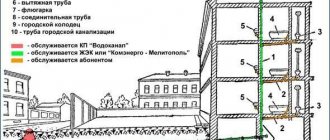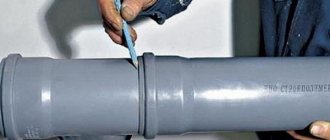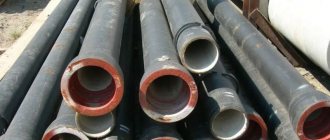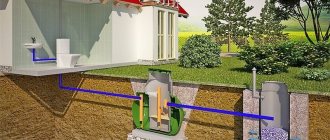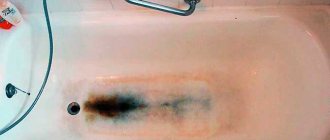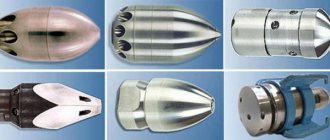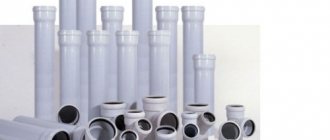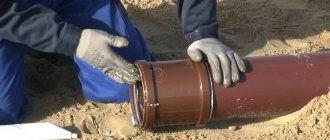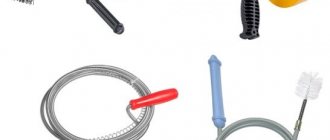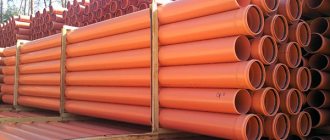If the water from the plumbing equipment began to drain slowly, and then stopped altogether, then your sewer system is clogged. Cleaning sewer systems is not the most pleasant process, but it is necessary. A person with little skills in such work can easily cope with this problem on their own.
Usually, when you need to clean a sewer pipe, the first thing that comes to mind is a sullen plumber with a cable. Of course, calling a specialist will save you from having to clean the system yourself. Only often the workers of such services work extremely dirty, and the owners have to clean up after them, and the cost of such work is sometimes very undemocratic. In large regions of our country, cleaning a sewer in a classic apartment will cost from 1,500 to 5,000 rubles, depending on the timing of completion and the equipment used.
At the same time, in apartments, unlike cottages and private houses, blockages in the sewer system are often quite complex. Knowing the main principles of the sewer system and existing cleaning methods, you can deal with almost any blockage with your own hands.
How is the sewer system arranged in the apartment?
The sewer system of an ordinary apartment in a multi-storey building starts from the most important plumbing equipment - the kitchen sink siphon. From this, a sewer pipe, usually 50 millimeters in size, passes through the bathroom, simultaneously receiving waste water through the sink and bath siphons, and then adjoins a 100 mm toilet outlet connected to the sewer riser.
Over the years, during the construction of apartment buildings, other designs of sewerage systems were used to save money. For example, you can find houses where one sewer pipe serves several apartments located on the same floor. In modern houses, when planning apartments, more attention is paid to comfort, so the sewage system may be more complex. Sometimes the toilet is connected to the riser using a separate outlet, and additional structures are provided for washing machines and dishwashers. In apartments with several bathrooms, two risers are also installed.
The sewer riser collects wastewater from all apartments located from top to bottom, and then discharges it into the sewer well, from where it enters the main line. Further, through a long communications system, which includes several kilometers of pipes, pumping stations and inspection wells, wastewater flows into treatment facilities.
Using this scheme, you can determine whose efforts should resolve problems in the sewerage system. All problems with pipes located in the apartment up to the sewer riser must be resolved by the owner of the premises and eliminated at his own expense.
Clogging of sunbeds up to the first sewer well and risers is eliminated by the organization that services the apartment building, through payments from residents for routine repairs and maintenance of common property. Any attempts to raise additional money for such work are prohibited. However, this does not relieve residents from liability if the sewerage system was not used for its main purpose. For example, if foreign objects or accumulations of toilet paper are found in the riser, the management organization has the right to impose a fine. In practice, this rarely happens, because it is almost impossible to identify the true culprit in an apartment building.
Blockages in sewer lines are cleared by housing and communal services organizations through payments for sewerage and water supply. Attempts to collect funds for calling employees are prohibited. Any claims when foreign elements are found in the sewer can only be submitted to the management company, which can then deal with the residents.
The legislative framework
Most residents of apartment complexes ask questions about who is responsible for the water supply, who to contact if breakdowns occur in the system, and who is obliged to compensate for the damage. In addition, in force majeure situations, partial or major repairs of the pipeline are required. The law helps you figure out who to contact in each of these cases.
As follows from Art. 36-37 of the Housing Code of the Russian Federation, the management company (MC) or housing and communal services are responsible for maintenance and repairs. Current expenses are covered by the monthly utility bills of the building's residents. However, if the user himself is to blame for the breakdown, he will compensate for the damage caused.
The fact that housing and communal services are obliged to restore the operation of water supply systems in apartment buildings is also indicated by the Federal Law of July 21, 2007 No. 185-FZ “On the Fund for Assistance to the Reform of Housing and Communal Services.”
Why do pipes get clogged?
Clogged sewer pipes are an inevitable and constant process. Sooner or later, everyone is faced with the need to clean their drains. This occurs because insoluble sewage waste gradually accumulates in the system. The main cause of blockages is food debris from dishes coming out through the kitchen sink, so blockages in the area of the system from the sink drain to the bathroom drain can most often be found.
Remains of food gradually rot and turn into greasy black sludge with an unpleasant odor. The flow of water during draining carries the sludge through the pipe, smearing it on the walls. Gradually, the cross-section of the pipe narrows and the water stops draining normally. Experts call such blockages “chronic.” They are formed due to a large number of factors; the process can last from several weeks to several decades. Sometimes “acute” blockages occur due to large foreign objects entering the system at the same time and most often occur in the toilet drain.
If “chronic” blockages occur frequently, then the sewer system is most likely faulty. In apartment buildings, the sewage system is free-flowing, so for optimal drainage, the pipe must be at a certain slope towards the riser. If the riser slope is insufficient or too large, then the only solution is to completely dismantle the system and change the design. When installing a new system, it is better to use polymer products, as they clog much more slowly than metal ones.
If “acute” blockages occur frequently, this indicates improper use of the sewage system. The fewer solid elements that enter the sewer, the less often it needs to be cleaned. It is especially dangerous to use the system to dispose of residual wallpaper glue, plaster mortar or cement, as this can lead to complete breakdown.
What consequences may there be
The consequences of clogged sewer pipes can vary. If the problematic element turns out to be an indoor lounger, then there will be a slowdown or complete stop of the discharge of wastewater from sinks, bathtubs or toilets. Clearing such blockages is quite simple, you can even do it yourself.
Much more dangerous is a clogged sewer in the basement of an apartment building. He actually stops operating the sewer riser while they fix the problem. All this time, the maximum troubles will fall on the residents of the first floor, who will demand compensation for damage in court. The procedure is complex, requiring a search for the perpetrators and other actions.
Sewage leaks in the basement contribute to the destruction of the foundation, the appearance of rot and mold, mosquitoes, and the spread of infectious diseases. If leaks are detected, you should immediately call specialists.
Technologies for cleaning the sewer system
Initially, wastewater enters the siphons of plumbing equipment - washbasins, sinks, bathtubs. This is where the first part of the solid particles settles. If you notice that the water has begun to drain more slowly, first disassemble the siphons. Cleaning the siphons of the washbasin and sink is easy to do on your own and does not cause any special problems. Cleaning the bathroom trap is a little more difficult because it is not easy to get to. If the siphons are clean, but the water does not flow out well, you will have to clean the pipes. To do this, you can use the method of washing with boiling water, cleaning with chemicals, cleaning with a plunger, wire, cable or air.
Cleaning drains with boiling water
Flushing the sewer system with boiling water is the most common and simplest method. It does not require special equipment; boiling water perfectly washes away stuck fat. In an ordinary apartment with a sewer pipe approximately 3 meters long, you will need at least 5 liters of boiling water. It’s even better to use it in conjunction with washing powder, soap or baking soda. This method is best used for siphons and pipes made of cast iron, since plastic products may simply not withstand the temperature and become deformed.
The advantages of this technology include the simplicity of the process and the absence of the need to dismantle the structure, but the disadvantages are that boiling water can only remove silt and grease blockages and can damage pipes and siphons made of polymers.
Preventative work
Preventive measures can prevent blockages from occurring. These events include:
- flushing drains with boiling water;
- a ban on throwing household, food waste and chemical components into the toilet;
- using a fat separator.
In everyday life, cleaning drains in an apartment is often done with vinegar and soda. There are many cleaning products available at your local hardware store that can help keep your pipes in optimal condition.
Preventive actions are aimed at extending the life of the pipeline and minimizing the likelihood of blockage.
In some cases, you can clear communications yourself, but in more serious situations you should contact specialists.
Cleaning pipes with a plunger
A plunger is a plumbing device that is a specially shaped rubber cuff attached to a plastic or wooden handle. Using a plunger, you can create a pressure difference that can remove the blockage.
When using this method, you need to fill the bathtub or sink with water 10 centimeters, close the overflow hole with a stopper, immerse the plunger in the water and press the plunger handle several times to create a pressure difference. The plunger will resist, at the same time draining wastewater. Finally, the plunger is pulled out of the water, which can cause debris to come out of the drain hole. If necessary, the procedure is repeated. When using this device, you can remove quite complex blockages without disassembling the system, but it will not be able to remove old dense sludge plugs.
Blocked riser: symptoms
It’s easy to understand that the riser is clogged:
1. Residents of the top floors have water in all plumbing fixtures. She just doesn't go away.
There is nothing and no one above. Only the attic and roof. Either something was thrown into the sewer vent, or the bird made a nest (which is unlikely).
2. For residents of one of the lower floors, the picture of the blockage looks brighter. Sewage from the neighbors above pours out of the original toilet directly onto the floor.
And, of course, the residents of the upper floors are to blame for this.
Cleaning the system with chemicals
This technology is based on dissolving blockages using acids or alkalis. Alkalis are excellent at clearing clogs of grease and sludge, while acids are most effective at removing soap residue and hair from pipes. The composition of all products is almost identical. When using, you must observe safety precautions and follow the instructions exactly. Many substances, after contact with water in the siphon, can splash and boil, which will negatively affect the enamel coating of the equipment. Chemicals do not require disassembling the system and can remove fairly complex blockages of all types, but they are not suitable when the drain is completely blocked, they can ruin pipes made of any materials and adversely affect human health if used incorrectly.
Prevention measures
To eliminate the possibility of blockages in pipes, you must follow the rules for operating the sewer system:
- do not throw construction waste or paper (except toilet paper) into the toilet;
- Do not pour food waste into the system;
- Avoid throwing away cat litter, especially those based on clay and sawdust.
These simple rules will help maintain the functionality of the system and eliminate possible problems in relations with neighbors and employees of the management company.
How to clean pipes with a cable
Dense blockages made of grease, silt or foreign objects can be removed using wire or plumbing cable. Steel wire approximately 4 millimeters thick is perfect if the structure has a straight shape and there is free space in front of it. An important advantage of this approach is the fact that a hook can be made at the end of the wire and the foreign object can be pulled out of the sewer system. It is better to use a cable in cramped conditions and in the presence of bends.
To access the pipe, the system must be disassembled by disconnecting the siphon closest to the blockage. The wire or cable is pushed into the pipe and gradually rotated. To do this, the wire is bent at the end, making something similar to a handle. The plumbing cable is always equipped with a handle for rotation. It is best to work with wire or cable in pairs, when one person rotates the device and the other feeds it into the system. If the cable gets stuck, you need to pull it back a few centimeters, start rotating and push it further. You should be careful with old plastic sewers, because you can accidentally pierce the cable through the bends.
When pulling out the cable, some dirt may end up on the floor. To avoid this, the wire or cable must be pulled out of the pipe through a rag. After clearing the blockage with a cable, the system is washed with boiling water or hot water.
To more effectively combat blockages, cleaning machines are used. Such equipment independently rotates the cable using an electric motor, which allows you to work without the help of a partner. Such machines are inexpensive, and it is very convenient to use them for cleaning short pipes.
Using a cable, you can remove any type of blockage, but the sewer system will still have to be partially disassembled.
Deadlines for emergency response
According to clause 5.2.2 of the TEZhF PiN (Rules and Standards for the Technical Operation of the Housing Stock, approved by Resolution of the State Construction Committee of the Russian Federation No. 170 dated September 27, 2003), applications for damage to utilities and structural components of the house are considered within a few hours after their submission, and carried out no later than the next day.
Sometimes it takes a longer time to fix an emergency in the sewer and water supply, or the technicians do not have the necessary spare parts. Taking into account the circumstances, a decision is made, of which the applicant is informed.
The deadlines for eliminating accidents in the housing and communal services sector are set out in Appendix 2 of the Rules and Regulations of the TEZhF.
If a breakdown poses a threat to the safety of residents, it is repaired as quickly as possible. Emergency faults of pipes and their connections with fittings, fittings and various devices should be dealt with immediately.
